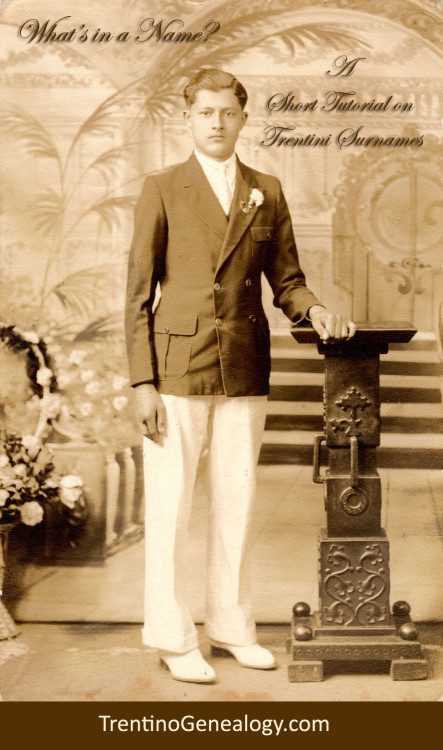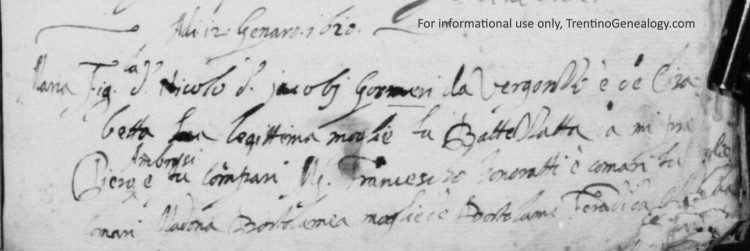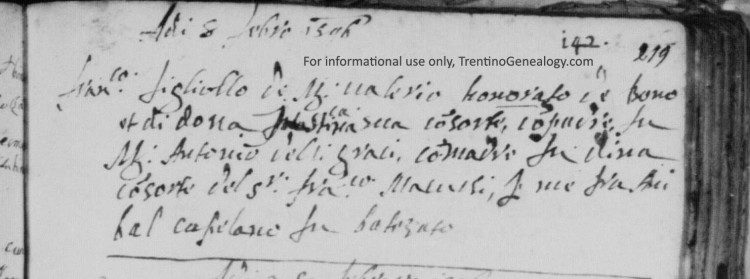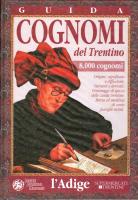
Genealogist Lynn Serafinn shares tips for researching your Trentino family history, and tells what you need to know about your ancestors’ surnames.
When it comes to family history, all research springs from one thing: a NAME.
Our Trentini ancestors had wonderful names – rich in meaning, culture and history. Having a solid understanding of the names of Trentino is crucial to constructing an accurate picture of your family history. That’s why, over the next few articles on this blog, I’ll be looking at some of the idiosyncrasies of our ancestral names so you can more easily identify your ancestors in historical records, and have a better understanding our colourful heritage. In today’s article, we’ll be taking a look at cognomi – surnames.
SIDE NOTE: I’ve made a searchable database of Trentini surnames on this site. CLICK HERE to view it and see if your surname is currently on our “One Tree” project family tree.
Changes to Surnames after Immigration
The first thing to remember is that many of our ancestors who immigrated to the Americas changed their surnames to make them sound less “foreign”. Surprisingly, some descendants might not even be aware this change occurred. Such was the case with me. When I was growing up, neither I nor many of my cousins knew our family name was actually Serafini. But after my dad died, I discovered our original name when I started digging into our family history. I even found the official change of name request my grandfather had filed in the 1930s. This meant that my dad had been known by the surname Serafini until he was in his late teens, but (for reasons unknown) he chose not to tell me. It was a bit of a shock to discover that something I had been told since childhood was an untruth. Be prepared for the possibility of unearthing a few of your own skeletons as you do your research!
Natural Evolution of Surnames Over Time
Prior to the 18th century, surnames were still in a state of evolution, and your surname will probably look very different the further back you go in time. One example is the surname Gusmerotti. This name is likely to be written as Gosmero or Gosmeri in records from the 1500s and early 1600s. This is because Gusmerotti comes from the masculine first name Gosmero plus the suffix -otti (meaning large).
Click on the image below to see it larger.

Another example is the surname Devilli. Prior to the 19th century, you will typically find it written as either “de Vigili” or simply Vigili. The term “vigili” refers to someone who keeps guard. As a name, it was first used to refer to specific branches of the military during the reign of the Prince Bishops. Thus, knowing the origins of your surname can sometimes give you a clue as to what some of your ancestors did for a living.
Latin Version of Names in Parish Records
Until the late 18th century, Latin was the language used in Trentini parish records, rather than Italian. While this practice was nearly always used in the spelling of first and middle names (which we’ll explore next time), it could occasionally also alter the spelling of surnames. One example is the surname Onorati, which was frequently written in its Latin forms, Honoraty, Honorati or Honorato.
Click on the image below to see it larger.

Forget About Spelling!
Even after modern surnames began to “stick”, there was no concept of standardised spelling until relatively recently. For example, the surname Caliari can also appear as Calliari, Cagliari or Caliary.
Along the same lines as the Devilli example above, any kind of “conjunct surname” (one that was originally two separate words) could appear either as a single word or two separate words. For example, the name Daldos might show up as Dal Dos or Dal Doss.
Generally speaking:
- Consonants in between vowels might be doubled or left single (Benassuti, Bennasuti, Bennassuti)
- The letter “a” is often interchangeable with the letter “o” (Bonomi, Bonami)
- The letter “e” is often interchangeable with the letter “i” (Rocche, Rocchi, Roche, Rochi)
- A “g” can sometimes appear before an “ni” or “li” (Cagliari, Caliari, Benini, Benigni)
This flexibility means it is not uncommon to see different surname spellings in the birth, marriage and death records for members of the same family (or even for the same individual). So, it’s important to remember that variations in spelling do not normally indicate the person is from different family, as it would in modern English-speaking culture.
SIDE NOTE: Research become even more complex when you add to this the plethora of variations you will see in first and middle names (which we’ll look at next time)!
Surnames of Women in Trentino
When researching your female ancestors, you need to remember that women in Trentino do not take their husbands’ name when they marry, but retain their fathers’ surnames throughout their lives. So, when researching your female lines, don’t try to find them under their husbands’ names, as you won’t find them. Also, if you use software for your family tree, make sure it is set so it doesn’t automatically change the women’s surnames to their husbands’.
Soprannomi – A Blessing or a Curse for Family Historians
Lastly, it’s worth mentioning “soprannomi” (plural). A soprannome (singular) is an add-on or nickname sometimes given to one branch of a family to distinguish it from other branches. While saying “Giovanni son of Giovanni” can help distinguish that person from “Giovanni son of Pietro”, sometimes there are just too many Giovannis to know who is who. That is where a soprannome can be useful. For example, the branch of the Serafini family from which I am descended was given the soprannome “Cenighi”. This soprannome was chosen because Margherita Giuliani, the wife of my 4x great-grandfather Alberto Serafini, came from the village of Ceniga in Drò parish.
For the genealogist, a soprannome can be a blessing OR a curse. You might come across a baptismal, marriage or death record where the priest used ONLY the soprannome, omitting the person’s surname completely. When that happens, if you don’t know the soprannome (or you’re not paying attention) you might accidentally gloss over the record you’re looking for.
Coming Up Next…
 I hope this article has got you interested in knowing more about all the wonderful Trentini surnames that make up your heritage. If you’d like to dive more deeply into the subject, there are many excellent books available in Italian. One I use almost on a daily basis is Guida Cognomi del Trentino by Aldo Bertoluzza.
I hope this article has got you interested in knowing more about all the wonderful Trentini surnames that make up your heritage. If you’d like to dive more deeply into the subject, there are many excellent books available in Italian. One I use almost on a daily basis is Guida Cognomi del Trentino by Aldo Bertoluzza.
Next time, we’ll be looking at things every family historian needs to know about our ancestors’ first and middle names. If you subscribe to Trentino Genealogy blog (see the form on the top-right side of this page), you’ll be sure to receive that article via email, along with all upcoming articles.
Until then, I look forward to reading your comments or questions below. And if you have any comments or questions, I cordially invite you to drop me a line with me via the contact form on this site.
Warm wishes,
Lynn Serafinn
Subscribe to receive all upcoming articles from Trentino Genealogy! Desktop viewers can subscribe using the form at the right side at the top of your screen. If you are viewing on a mobile device and cannot see the form, you can subscribe by sending a blank email to trentinogenealogy@getresponse.net.
Lynn on Twitter: http://twitter.com/LynnSerafinn
Join our Trentino Genealogy Group on Facebook: http://facebook.com/groups/TrentinoGenealogy
View My Santa Croce del Bleggio Family Tree on Ancestry:
https://www.ancestry.com/family-tree/tree/161928829

LYNN SERAFINN is a bestselling author and genealogist specialising in the families of Trentino. She is also the author of the regularly featured column ‘Genealogy Corner’ for Filò Magazine: A Journal for Tyrolean Americans.
In addition to her work for clients, her personal research project is to transcribe all the parish records for the parish of Santa Croce del Bleggio (where her father was born) from the 1400s to the current era, as well as to connect as many living people as she can who were either born in Bleggio or whose ancestors came from there. She hopes this tree, which already contains tens of thousands of people, will serve as a visual and spiritual reminder of how we are all fundamentally connected.
View the Santa Croce del Bleggio Family Tree on Ancestry:
https://www.ancestry.com/family-tree/tree/161928829
CLICK HERE to view a searchable database of Trentini SURNAMES.

I have tried to find my great grandmother for years. I was told that she was raised in a nunnery. How can I get more info on her? She was born in 1850 and died in Drena, Trento, Italy in 1932.
Thanks
Hi Gerri. It is possible she was born in the Institute of the Madonna delle Laste in Trento, which was not so much a nunnery as it was a maternity home serving the entire province during that era (it was shifted to Innsbruck in 1870). The records for babies born there are kept in the Provincial Archives in Trento. The records are not available online, but you could write to the archives to see if they have her name in their database.
Hi! My name is Felipe Serafini, I’m from Argentina, I want to know the origin of our surname, I read some information that classified the surname: Serafini is an italian surname derived from the name Serafino; Serafini is a Frank surname; Serafini is a polska surname. So, we know Serafini is most prevalent in Italy, but Lynn, what is the origin of the Serafini in Italy, is Frank? Jew? Italian?
I look forward your answer
Hi Felipe! Thanks for your question and welcome to Trentino Genealogy. ‘Serafini’ is indeed an Italian surname which is derived from the male personal name ‘Serafino’, or ‘Seraphinus’ in Latin. The ‘i’ at the end is a Latin ending that means ‘of’ or ‘belonging to’. Thus, ‘Serafini’ means ‘(the family) of or belonging to Seraphinus’. Now, the word ‘Seraphinus’ itself comes from either Hebrew or Greek ‘Seraphim’ (I’ve seen it cited as being from both), and it is certainly a word used in the Old Testament, referring to the highest of the nine classes of archangels. In Italian language, the man’s name Serafino is like saying ‘Archangel’, the same way ‘Angelo’ means ‘angel’, ‘Santo’ means ‘saint’, etc.
However, just because the word ‘Seraphim’ comes from Hebrew, that is NOT to say the personal name ‘Seraphinus’ or the surname ‘Serafini’ is of Jewish origin. Because this is a very old Biblical word, the male personal name will appear in many other cultures around the world, especially in those countries that were Catholic (including places like Poland and France, as you point out). However, it does not mean that any of these ‘Serafini’ (or similar surnames) are related in any way. It just means that at some point in the past, there was a patriarch whose name was ‘Seraphinus’ or ‘Serafino’ or whatever the local spelling would have been. Even in Italy, the surname Serafini is extremely widespread, and it would be 100% incorrect to assume they had a blood connection to each other. It is likely to be the case if you are studying small, insular populations, but not if they are far from each other. For example, I know from my research that all the Serafini in the parish of Bleggio in Val Giudicarie (Trentino) are descended from the same couple, and that the patriarch of that line came from Preore/Ragoli. However, they are not related to Serafini who came from Val di Cembra, for example.
Please also be aware that I have seen many people sharing family ‘crests’ (stemmi) for Serafini, and the same thing would apply, i.e. a crest associated with a certain surname does not mean it belongs to everyone with that surname.
I hope that helps to answer your question?
Hello, my mother’s family name is Trentin and we live in the french part of Canada. The parents of her father were both Italian, and they had the surname Trentin and Da Ros. I was wondering if my mother’s surname « Trentin » could have changed when her grandfather arrived in Canada. Was it maybe Trentino or Trentini or is it possible that it was already Trentin back in Italy?
Thanks in advance
Hi Guillaume. Thanks for reading and for your question. Trentin appears in many parts of Italy, but mostly in the north (Veneto, Lombardia and Trentino-Alto Adige). See the Cognomix website entry at https://www.cognomix.it/mappe-dei-cognomi-italiani/TRENTIN. In Trentino, I have seen the name more frequently as ‘Trenti’ or ‘Trentini’. Dropping the final vowel is most common in the region of Veneto, where the name ‘Trentin’ is the most common, and especially in the provinces of Vicenza and Treviso. Similarly, the surname ‘Da Ros’ is most commonly found in the region of Veneto (see https://www.cognomix.it/mappe-dei-cognomi-italiani/DA_ROS), and especially in the province of Treviso. In Trentino, you would more often see ‘Dal’ instead of just ‘Da’ (although sometimes you will just see the ‘da’). So, my guess would be that these are the original surnames, and that your family came from the region of Veneto, and most likely from the province of Treviso. You might wish to check the Antenati website at http://www.antenati.san.beniculturali.it/?lang=en to see if they have any records from those provinces (the state archives are always organised by province). It isn’t a site I use often, because they do not have records for Trentino, which is my area of specialism. Best of luck with your research!
Warm wishes,
Lynn Serafinn